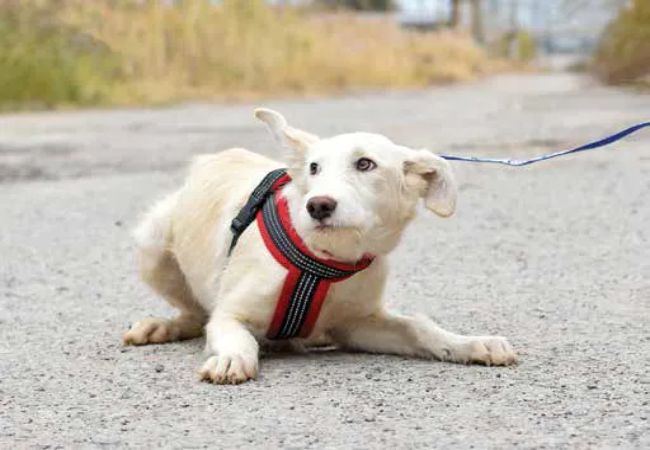Dog Freezes in Harness? Vet-Approved Reasons & Fixes 2025 🐕🩺

In this article
Dog Freezes in Harness? Vet-Approved Reasons & Fixes 2025 🐕🩺
By Dr. Duncan Houston BVSc
Ever clip on your dog’s harness only for them to freeze like a statue? You’re not alone—and it’s not defiance. As a veterinarian and founder of Woopf, I’ve seen this behavior hundreds of times, especially in puppies or rescue dogs.
The good news? It’s fixable. Let’s look at why your dog is freezing, what it means, and how to help them feel confident and mobile in their harness.
🧠 Why Dogs Freeze in a Harness
1. ❌ The Harness Feels Restrictive
Some dogs interpret the sensation of a snug-fitting harness as physical restraint. It’s a new pressure around their chest and shoulders, which can feel unnatural—especially at first.
2. 🧠 Learned Helplessness
Dogs that associate the harness with stress (forced walks, punishment, or negative past experiences) may shut down instead of acting out.
3. 🩺 Physical Discomfort or Pain
A harness that’s too tight, too loose, or rubbing on sensitive spots can cause your dog to freeze in anticipation of pain.
4. 🐾 Developmental Stage (Puppies)
Young dogs, especially under 14 weeks, are still adjusting to body sensations. A harness can overwhelm their sensory system if introduced too fast.
📚 What the Science Says
Research from PubMed and Elsevier’s veterinary behavior journals confirms that freezing behavior in dogs is a common anxiety response—not disobedience. It’s a survival reflex to unfamiliar, uncomfortable, or overstimulating situations.
✅ How to Help Your Dog Stop Freezing
Step 1: Rule Out Fit or Physical Issues
Check for signs the harness is too tight, loose, or irritating the skin. Common red flags include:
- Hair loss or redness under straps
- Discomfort during movement or stairs
- Harness slips or shifts when walking
Fix: Refit using the two-finger rule or upgrade to a better-fitting harness like the Woopf Explorer Harness.
Step 2: Reintroduce the Harness Gradually
Training Steps:
- Let your dog sniff and interact with the harness on the floor
- Touch it to their chest or back without clipping on
- Clip it on for 3–5 seconds, then remove and reward
- Slowly increase wear time each day
Step 3: Make the Harness Predict Fun
Right now, the harness might signal “discomfort” or “fear.” Flip the association:
- Put it on just before meals or playtime
- Clip it and give a treat—then unclip
- Use it indoors for short positive sessions
Step 4: Let Them Move Freely Indoors
Some dogs need to feel like the harness isn’t a trap. Encourage movement with food trails, play, or leash-follow games.
🛍️ Recommended Products for Dogs That Freeze
- Sherpa Harness: Lightweight and non-restrictive for puppies or sensitive dogs
- Bungee Lead: Reduces leash pressure during start-stop movement
🔁 Common Mistakes to Avoid
- Forcing walks before your dog is ready
- Using a tight, poorly adjusted harness
- Skipping positive reinforcement
- Leaving it on all day—causing mental fatigue
🎓 Positive Outcomes: What to Expect
With proper training and the right gear, dogs typically stop freezing within a few days to a few weeks. They begin associating the harness with movement, fun, and freedom instead of stress.
Final Thoughts
If your dog freezes when the harness goes on, they’re not stubborn—they’re unsure. With a little patience and a vet-designed solution from Woopf, you can turn walks into the best part of their day.



